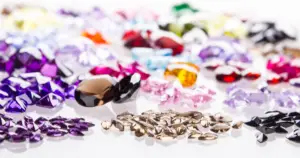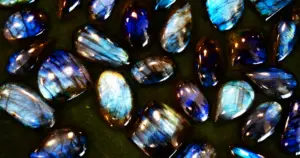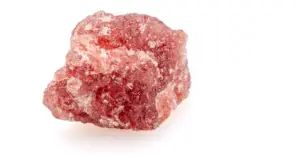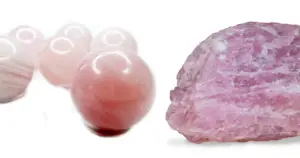How to Tell if Agate is Real or Fake in 4 Easy Ways
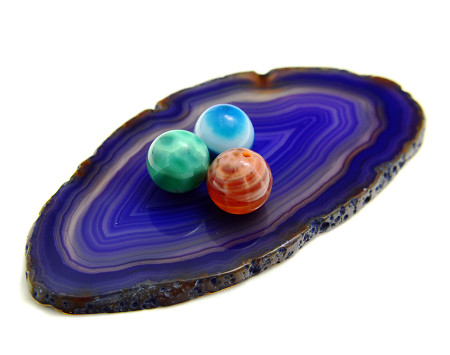
The term ‘‘Agate’’ is used as a catch-all to refer to variously shaped banded arrays of silica minerals filling cavities in volcanic and, less commonly, sedimentary rocks and gems and can be confused and easily be faked, hence buyers should know how to differentiate if Agate is Real or Fake.

Let us see a few Identification Methods of Real Agate.
Agate occurs with several individual bands, concentric to the external surface of the mass or nodule, such that successive layers of banding are different in color and translucency. Containing mixed-colored stones, named so because tourmalines were often confused with others.

Table of Contents
How can Agate be Faked?
- Agate is mostly valued for the intricate patterns that occur on its surface. Nothing exhibits these patterns more vividly than when set against the striking abundance of minerals found in the Earth’s surface, which lend Agate crystal not only their chemical composition but also their characteristic vibrancy.
- Despite being highly valued for its color, naturally occurring Agate is most often a dull gray. To increase their market value and also to appear visually appealing, most Agate crystals found in markets today are dyed to give strong, visually appealing, and commercially acceptable colors. Due to their sturdy physical composition, Agate crystals can withstand industrial abuse and are often sawn and shaped clean before dyeing.
- The rock, when immersed in hot sugar solutions and concentrated sulphuric acid alongside high heat gives black. Most Blue agates are treated with potassium and iron sulfate solutions to give them their resplendent blue hue. Yellow to greenish-yellow agate crystal is also obtained by artificially heating dry agate that has been treated with concentrated hydrochloric acid.
- An easier class of fakes to identify are those that are not Agate altogether. These are often made with such materials as glass, resin, plastic, etc.
- Such imitations and dyed varieties, due to their economic viability abound the crystal market, often to the outnumbering of genuine Agates. If you are looking to buy an Agate stone, you must start by getting a toehold over its dynamic universe of occurrences and physical appearances. Here, on offer, is a guide to Agate buying, some of its several varieties, its optical and tactical properties, and tips to identify fakes.
How to Identify a Real Agate?
Coloration
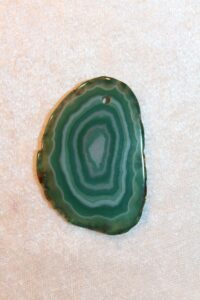
Agate can be of almost any color imaginable, the most frequent colors, in order of occurrence being: gray, white, brown, salmon, red, orange, black, and yellow. Shades of violet or a grayish-blue though marketed most abundantly are very unusual. A real Agate of such coloration is extremely hard to find and therefore exorbitantly priced. If you are buying modestly priced jewelry with deep coloration, you can be assured it is either dyed or fake.
The coloration in an Agate is caused by various embedded minerals, known as inclusions, of which iron oxides and hydroxides are most common, lending Agate its yellow, brown, and red colors. A pure agate, that is one without any mineral impurities, is white, gray, or a dull blue-gray.
Hardness
Since Agate is a cryptocrystalline quartz variety, its hardness is the same as quartz, which is a 7 on the Mohs scale. The hardness test is a great way to guard against such fakes as glass or plastic which are softer. One way to check the hardness of your Agate is to scratch its surface with a knife. If it gets scratched easily, it is a fake.
Fibers
An important, yet well-hidden feature of agates is their fibrous structure. No imitation can ever replicate the fibrous structure of real Agate. This is, therefore, a sure-shot way to tell if your Agate is real or not.
Agates, as we have discussed, are made of microscopic quartz crystals, but these are not oriented randomly. They are arranged in groups of roughly parallelly oriented crystals, and these groups form what gemologists called fibers.
To the naked eye, these fibers may mostly be invisible, as they are all made of the same material and the optical properties of the fibers are almost identical. If you happen to have a slice of Agate that is very thin and colorless, the fibrous nature gets revealed to the unaided eye. One way to tell if your colored Agate slice is real is to point a flashlight from behind it and observe its surface. In a real Agate with concentric banding, you should be able to notice gossamer fibers (spider web fibers).
A real Agate, when illuminated from the behind, with a pointed light source like a torch, should look like a spider’s web, with fine lines emanating from the rim of the geode to its center. These lines run perpendicular to the agate banding. The pattern is stronger in the periphery and gets weaker as we get to the quartz center of the agate.
Look for Inclusions
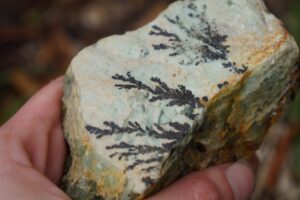
For solid inclusions, there are several distinct types found in Agate. These include:
- Sheetlike or tubular growths generally of greenish-gray color;
- Slender black crystals and outgrowths of same in the form of exceedingly thin platelets;
- Minute opaque dots occurring alone or in clusters of the various general form
- Opaque inclusions as clots and curds in a variety of colors
- Acicular needles of some unknown mineral or minerals, slender distorted rhombohedral and normal rhombohedral crystals of calcite, and dark brown curved rhombohedral crystals
- Spots, veils, plumes, and moss-like filaments of contrasting color are seemingly suspended in pools of translucent material. For a great many years, such growths, especially the kinds which look like algae, were regarded as real fossilized vegetative matter.
How to Spot a Fake Moss Agate?
Try to locate Seams on the Stone
Moss agate is imitated by placing some chemical, like manganese dioxide, with thin gelatine on one surface of a glass plate. When the chemical has spread itself in a tree-like formation on the gel, the excess water is driven off by gentle heat, and the second plate of glass is cemented on, to act as a cover. The whole is then ground and polished in cabochon form.
One way to tell if a moss agate is fake is to look at the edges of your stone for seams. When a moss agate is faked by cementing two thin layers of glass onto each other as described above, you can easily notice a joint where the two sheets of glass are pasted together. A real Agate stone will never have a seam or a joint that appears to trap patterns inside two translucent sheets like a frame.
What are the Common Varieties of Agate? How to Identify them?
Fire Agate
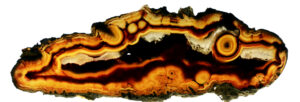
This terrific variety of Agate is among its most fascinating. The layer of mineral that gives the beauty and fire to this variety of agate is iridescent limonite or a type of iron oxide.
The fire layers trapped between layers of agate are so thin that they are sometimes less in thickness than a breath upon a windowpane. The distribution of fire in each layer typically has a dense spot in the center, thinning out towards the edges.
This dense spot ordinarily is where the best colors are dominant. Because of its complex and fragile structure, it cannot be handled in quite the same manner as other varieties of agate and is, therefore, best bought raw or unpolished. To polish fire agates requires an umpteen amount of skill. Such a rock would sell for an incredibly high value.
Fortification Agate
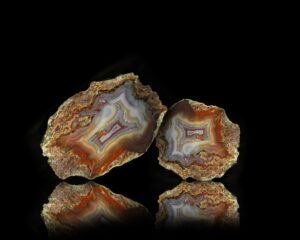
This is one of the most commonly occurring forms of banding in Agate. This Agate gets its name from the appearance of its banding. In a Fortification Agate, layers of minerals show sharp angles, echoing the plan of old forts.
Onyx
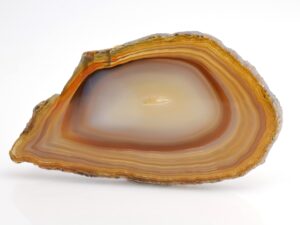
This term is used for agate with milky-white or white bands alternating with bands of black or dark brown
Iris Agate
These usually occur with a center of massive quartz crystals. They may sometimes even have hollow quartz-lined centers, like the ones observed in the druzy stones in the adjacent picture, with the chalcedony bands around the edge in which we find the play of the rainbow coloring.
Sometimes these bands are adjacent to the quartz crystal center. However, this characteristic can be reversed, with the bands or fortification lines in the very center of an agate which has radiating quartz crystals around them. The latter is extremely rare and therefore, incredibly high priced. These may have iris all over the surface and before a light, they resemble a solid piece of fire opal.
What is the difference between Chalcedony and Agate?
Agate is a type of chalcedony, which in gemological taxonomy, is any variety of silica that has ingrown quartz crystals. Chalcedony is therefore a kind of cryptocrystalline (hidden/ingrown) quartz.
While buying Agate, you may encounter chalcedony and agate being interchangeably used to refer to the same thing. To the uninitiated Agate buyer or hobbyist, gemological jargon, baffling as it is, is often deployed to obscure the origins of rock and sell a fake.
To set the record straight: All chalcedony is not agate but is often marketed as that.
A chalcedony typically qualifies as an agate if it exhibits any of the following properties:
- Banding of some kind, caused either by different colors of the composite minerals or different structures of the layers
- Translucency alongside being multicolored
- Translucency occurs with a nodular shape and colored inclusions
So a typical agate looks like a nodule filled with a translucent, multi-colored chalcedony with parallel bands.
Does Agate only occur with concentric banding?
No. Among the several varieties of chalcedony that are clubbed under the Agate category, some occur with small spotty, spore-like mineral inclusions, spread over the surface of the crystal, which due to their resemblance to moss, are often called Moss Agate.
Moss Agate, as can be seen in the adjacent picture, is a pale bluish, grey, or yellow translucent to sub- transparent chalcedony containing dendritic tree-like inclusions of various oxides.
Their color varies from most commonly occurring black to red and green inclusions. Moss agate is also sometimes sold as a Mocha Stone. The best-known locality for green moss agate is the Deccan trap rocks of India.
Final Comments
No mineral in the crystal universe quite matches up to the diversity and marvelous formations that Agate displays. What makes Agate ceaselessly unique is also what makes it obscure to the novice buyer.
While Agate’s fakes abound in the market today, they can come nowhere close to resembling the enigma that is this rock. So your best bet while buying an Agate is to understand its physical occurrences and locate those in whichever rock you choose to buy.
Here we have presented you a non-exhaustive guide to understand Agate’s striking physical features: its banding, fibers, translucency which can help you avoid fakes. Share this article to whom you care.
